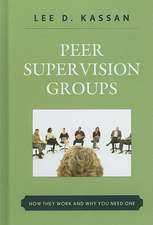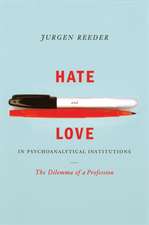Psychoanalysis Meets Psychosis: Attachment, Separation, and the Undifferentiated Unintegrated Mind
Autor Michael Robbinsen Limba Engleză Paperback – 15 apr 2019
In Part One Robbins describes how the medical model of psychosis underlies the current approach of both psychiatry and psychoanalysis, despite the fact that neuroscience has failed to confirm the model's basic organic assumption. In Part Two Robbins examines two of Freud's models of psychosis that are based on the assumption of a constitutional inability to develop a normal or neurotic mind. The theories of succeeding generations of analysts have for the most part reiterated the biases of Freud's two models, so that psychoanalysis considers the psychoses beyond its scope. In Part Three Robbins proposes that the psychoses are the result of disturbances in the attachment-separation phase of development leading to maladaptive persistence of a primordial form of mental activity related to Freud's primary process. Finally, in Part Four Robbins describes a psychoanalytic approach to treatment based on his model. The book is richly illustrated with material from Robbins' clinical practice.
Psychoanalysis Meets Psychosishas the potential to undo centuries of alienation between society and psychotic persons. The book offers an understanding of severe mental illness that will be novel and inspiring not only to psychoanalysts but to all mental health professionals.
| Toate formatele și edițiile | Preț | Express |
|---|---|---|
| Paperback (1) | 335.44 lei 6-8 săpt. | |
| Taylor & Francis – 15 apr 2019 | 335.44 lei 6-8 săpt. | |
| Hardback (1) | 1095.75 lei 6-8 săpt. | |
| Taylor & Francis – 24 apr 2019 | 1095.75 lei 6-8 săpt. |
Preț: 335.44 lei
Preț vechi: 353.09 lei
-5% Nou
64.19€ • 66.93$ • 53.35£
Carte tipărită la comandă
Livrare economică 21 martie-04 aprilie
Specificații
ISBN-10: 0367191172
Pagini: 206
Dimensiuni: 156 x 234 x 11 mm
Greutate: 0.38 kg
Ediția:1
Editura: Taylor & Francis
Colecția Routledge
Locul publicării:Oxford, United Kingdom
Public țintă
Postgraduate and ProfessionalCuprins
Introduction
PART I: NOT FULLY HUMAN: THE UNWITTING COLLUSION BETWEEN MEDICINE AND PSYCHOANALYSIS
1: Not fully human: Psychiatric and psychoanalytic understandings of psychosis
2: The medicalization of madness: Evolution of the equation of psychosis with degeneracy
PART II: PSYCHOANALYTIC MODELS OF PSYCHOSIS
3: Freud’s attempt to treat psychosis as though it were neurosis
Obsessive-compulsive thoughts or delusional/hallucinatory enactments?
Freud’s interpretive enactment of his theory of repressed unconscious and its results
4: Freud’s three models and their offspring i: The inability to relate
5: Freud’s three models and their offspring iia: The inability to integrate mind and become neurotic: The European Kleinian iteration
6: Freud’s three models and their offspring iib: The inability to be neurotic: the American ego psychology iteration of the integration model and Kernberg’s transatlantic rapprochement
7: Freud’s three models and their offspring iii: Thought disorder: the primary process
PART III: A NEW BEGINNING: DISTINGUISHING PSYCHOSIS FROM NEUROSIS
Clinical preface to chapters 8, 10, & 13
Jane
Jacob
Lisabeth
Charles
8: Two conscious mental processes: The role of primordial consciousness in psychosis and other human phenomena
Misconceptions of psychosis as an adult onset disorder of genetic origin
Characteristics of reflective representational thought
Characteristics of primordial consciousness or first mind
Clinical illustrations of primordial consciousness
Dreaming and primordial consciousness
Attachment and the commencement of psychic life
9: Return to the Rat Man: Psychosis as a manifestation of primordial consciousness
10: Psychosis as a disorder of attachment and separation-individuation
Psychosis and pathology of separation: The stages of separation
Relationship between schizophrenia and psychotic personality disorder: The false self
Clinical illustrations of false self
Good enough attachment and development of the two mental processes: Rank and Bowlby
Pathology of attachment, maladaptive persistence of primordial consciousness, failure to separate, and development of psychosis Clinical illustrations of pathological attachment and failure to separate
PART IV: TREATMENT OF PSYCHOSIS
11: The medical treatment of psychosis: Transforming psychosis from a socially disruptive to a socially adaptive disease
12: Studies of the efficacy of psychological and psychoanalytic therapies of psychosis
13: Psychoanalytic therapy of psychosis: Transforming primordial conscious mentation to reflective representational thought
The therapeutic process
The remembered and reconstructed past
The process of therapy
Stages of therapy with schizophrenic persons and psychotic personalities
Criteria of successful treatment and outcome
14: Qualities of a psychoanalytic therapist of psychosis
15: Patients write about their therapy
16: The 11 year therapy of a chronic paranoid schizophrenic woman
Background
Year one
Year two
Year three
Year four
Year five
Year six
Year seven
Year eight
Year nine
Epilogue
Discussion
17: Conclusion
References
Index
Notă biografică
Recenzii
For Robbins, psychosis is the consequence of a developmental pathway separate and independent from that of neurosis. It begins with problems of attachment and separation that produce early failures to separate self from object and integrate a cohesive sense of self. These failures leave one incapable of experiencing, sustaining and resolving intrapsychic conflict and lead "to inappropriate and maladaptive persistence of primordial conscious mentation in contexts where reflective representational thought would be appropriate and adaptive."-Howard B. Levine, MD, Editor-in-Chief, The Routledge Wilfred R. Bion Studies Book Series
'Robbins’ goal is to introduce psychoanalysis to psychosis in a way that is internal to psychoanalysis and at the same time independent of the neurosis model and the biases that attend it. He does so successfully in this carefully reasoned and clinically illustrated book, as he returns us to a theory of primitive mind and primary process that Freud himself intimated but never further developed. In so doing, Robbins joins the increasingly interesting minority of analysts who are trying to extend psychoanalytic theory to include the understanding and treatment of psychoses.
For Robbins, psychosis is the consequence of a developmental pathway separate and independent from that of neurosis. It begins with problems of attachment and separation that produce early failures to separate self from object and integrate a cohesive sense of self. These failures leave one incapable of experiencing, sustaining and resolving intrapsychic conflict and lead "to inappropriate and maladaptive persistence of primordial conscious mentation in contexts where reflective representational thought would be appropriate and adaptive.'
Howard B. Levine, MD, editor-in-chief, The Routledge Wilfred R. Bion Studies Book Series
'Psychoanalysis meets Psychosis is a book of great courage and extraordinary depth written by one of the great masters of contemporary psychoanalysis. It represents an important challenge to reductionist biological psychiatry, and to a psychoanalysis entrenched in conservative positions and apathetically limited to the treatment of neurotic patients. It will prove to be of particular importance for new generations that are evermore engaged in the treatment of almost impossible patients: patients that the bureaucracy of training institutes would consider untreatable and extraneous to psychoanalytic expertise. Every seasoned analyst and worker in the field of mental health has much to learn from the horizons opened by this volume.'
Riccardo Lombardi is a psychoanalyst, psychiatrist and doctor of medicine. To read this review in full, please see the following: Lombardi, R. (2023) Psychoanalysis Meets Psychosis. Attachment, Separation, and the Undifferentiated Mind, by Michael Robbins, 2019, New York, London, Routledge, Pp. 206., 34,99£, ISBN 9780367191177. International Journal of Psychoanalysis 104:793-796.
Descriere
Psychoanalysis Meets Psychosis proposes a major revision of the psychoanalytic theory of the most severe mental illnesses including schizophrenia. Freud believed that psychosis is the consequence of a biologically determined inability to attain and sustain a normal or neurotic mental organization. Michael Robbins proposes instead that psychosis is the outcome of a different developmental pathway. Conscious mind functions in two qualitatively different ways, primordial conscious mentation and reflective representational thought, and psychosis is the result of persistence of a primordial mental process that is adaptive in infancy, in later situations in which it is neither appropriate nor adaptive.
In Part One Robbins describes how the medical model of psychosis underlies the current approach of both psychiatry and psychoanalysis, despite the fact that neuroscience has failed to confirm the model's basic organic assumption. In Part Two Robbins examines two of Freud's models of psychosis that are based on the assumption of a constitutional inability to develop a normal or neurotic mind. The theories of succeeding generations of analysts have for the most part reiterated the biases of Freud's two models, so that psychoanalysis considers the psychoses beyond its scope. In Part Three Robbins proposes that the psychoses are the result of disturbances in the attachment-separation phase of development leading to maladaptive persistence of a primordial form of mental activity related to Freud's primary process. Finally, in Part Four Robbins describes a psychoanalytic approach to treatment based on his model. The book is richly illustrated with material from Robbins' clinical practice.
Psychoanalysis Meets Psychosis has the potential to undo centuries of alienation between society and psychotic persons. The book offers an understanding of severe mental illness that will be novel and inspiring not only to psychoanalysts but to all mental health professionals.



















